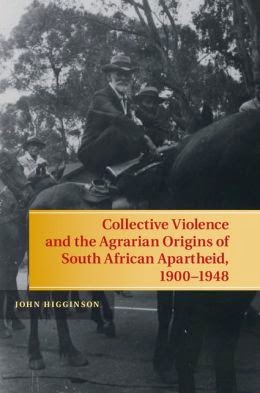 the University of South Africa in Pretoria, South Africa. He is the author of A Working Class in the Making: Belgian Colonial Labor Policy, Private Enterprise and the African Mineworker, 1907–1951 (1989).
the University of South Africa in Pretoria, South Africa. He is the author of A Working Class in the Making: Belgian Colonial Labor Policy, Private Enterprise and the African Mineworker, 1907–1951 (1989).Higginson applied the “Page 99 Test” to his new book, Collective Violence and the Agrarian Origins of South African Apartheid, 1900-1948, and reported the following:
Page 99 of Collective Violence and the Agrarian Origins South African Apartheid, 1900-1948 centers on the book’s preoccupation with large scale instances of violence as outcomes of capacity as opposed to instinct. The generalized perception among many Afrikaners at the end of the Anglo-Boer or South African War was that they had not just lost war but a way of life. By May 1902, British forces, combined with fifty thousand African irregulars (Jan Smuts’s “ Frankenstein monster created by fatuous policy”), had burned 3,700 square miles of enemy farmland to the ground, sequestered more than 200,000 Afrikaner and African women, children and old people of both sexes, and foiled the desperate attempt of the most capable enemy generals to foment an Afrikaner insurrection behind the war’s frontlines in the Cape Colony. Not only had the Boer republican army been defeated, in both its conventional and guerrilla iterations, but the prewar institutional supports of white supremacy had also been incinerated along with thousands of white farms.Learn more about Collective Violence and the Agrarian Origins of South African Apartheid, 1900-1948 at the Cambridge University Press website.
At the bottom of page 99 we find, G. G. Munnik, the former minister of Mines, bemoaning the war’s devastation and the way it had apparently empowered an African majority, if only for a brief period of time. Munnik’s generation of leadership was succeeded by men and a handful of women who surfaced during the closing phases of the war. More bloodthirsty and endowed with what Max Weber called “high animal spirits,” they wanted more than just revenge. Instead they determined to transform the entire political and social order in a manner that strenuously limited British interference in South Africa’s affairs and transformed the African majority into so many monitored strong backs and hands and little else.
Undeterred by the tragic outcomes of the failed white rural rebellion of 1914, the 1922 Rand Rebellion, and the 1932 depression and drought for both Africans and rural whites, they passed a corporatist and authoritarian vision of the future down to the next generation of Afrikaans speaking whites. Upon the triumph of the Afrikaner National Party in the all-white national election of 1948, this corporatist vision transformed itself into the Janus-faced policy of apartheid. Even though apartheid became a kind of fascism by fiat, the African majority fought back in myriad ways against the entire spectrum of violence –producing policies it generated, demonstrating just how contingent apartheid’s attempt to hijack the future of the African majority was.
--Marshal Zeringue



